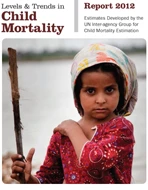 |
| Levels & Trends in Child Mortality: Report 2012 |
Substantial progress has been made towards achieving MDG Goal on Reducing Child Mortality but still insufficient – The new UN-World Bank child mortality estimates
New child mortality estimates (childmortality.org) show that substantial progress has been made towards achieving the fourth Millennium Development Goal. The estimates were released today by the UN Inter-agency Group for Child Mortality Estimation, which includes UNICEF, WHO, the World Bank and United Nations Population Division.
Since 1990 the global under-five mortality rate has dropped 41 percent, from 87 deaths per 1,000 live births in 1990 to 51 in 2011. Four of the six World Bank’s developing regions have reduced their under-five mortality rate by more than 50 percent: East Asia and Pacific, Europe and Central Asia, Latin America and the Caribbean, Middle East and North Africa regions. Progress towards Millennium Development Goal (MDG) 2015 target of a two-thirds reduction is also on track in these four regions. ("On track" indicates that under-five mortality is less than 40 deaths per 1,000 live births in 2011 or that the annual rate of reduction is at least 4 percent over 1990-2011.)
Under-five mortality rate by region, 1970-2011 (per 1,000 live births)
South Asia and Sub-Saharan Africa still lag behind, but they have made significant progress since 1990. The highest rates of under-five mortality are in Sub-Saharan Africa, where 1 in 9 children dies before age five, followed by South Asia where 1 in 16 children dies.
About 99 percent of under-five deaths occur in developing countries where 43 percent of deaths occur within the first month of life (the neonatal period).
Number of under-five deaths by region, 2011
In the new report, child mortality rates are available for the first time by sex. Biologically males are more vulnerable than females, so under-five mortality rates are usually higher for boys than girls. But mortality rates are higher for girls than boys in South Asia. In India, the largest country in the region, the under-five mortality rate of girls exceeds boys by 5 per 1,000 in 2011.
Under-five mortality rate by gender, 2011 (per 1,000 live births)
Most high-mortality countries do not have accurate vital registration systems, so the measurement of under-five mortality relies on extrapolations from household surveys. The UN Inter-agency Group for Child Mortality Estimation (UN IGME) was formed in 2004 to share data on child mortality, harmonize estimates within the UN system, improve methods for child mortality estimation, and to report on progress towards the MDGs. The UN IGME includes UNICEF, WHO, World Bank, and United Nations Population Division as full members. The continuous efforts of UN IGME and their Technical Advisory Group allow the world to have improved, reliable and transparent child mortality estimates.
All data, estimates and details on UN IGME methods are available on the Child Mortality Estimation Information (CME Info) website at childmortality.org. The new UN IGME child mortality estimates are also available on World Bank’s World Development Indicators database and HealthStats.



Join the Conversation